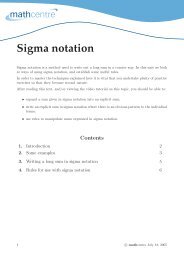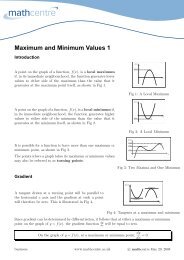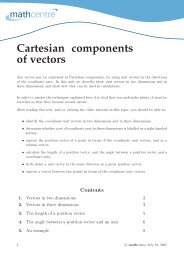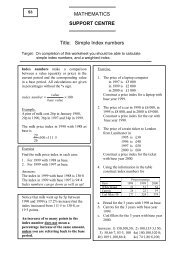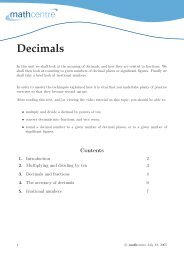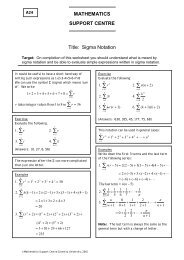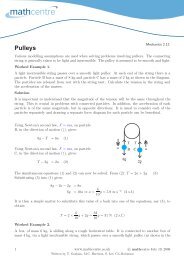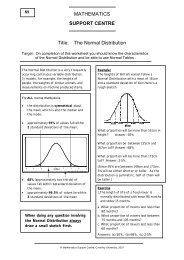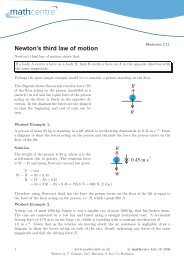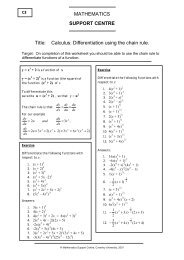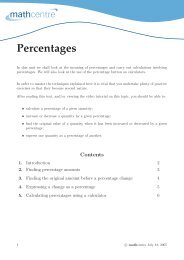indefinite integration as the reverse of differentiation
indefinite integration as the reverse of differentiation
indefinite integration as the reverse of differentiation
Create successful ePaper yourself
Turn your PDF publications into a flip-book with our unique Google optimized e-Paper software.
Exercises 2<br />
Evaluate <strong>the</strong> following limits <strong>of</strong> sums using antiderivatives.<br />
∑<br />
1. Find lim x 3 δx.<br />
2. Find lim<br />
3. Find lim<br />
x=1<br />
δx→0<br />
x=0<br />
∑x=2<br />
δx→0<br />
x=1<br />
∑x=1<br />
δx→0<br />
x=0<br />
x 4 δx.<br />
e 2x δx.<br />
4. Indefinite integrals<br />
As we have seen definite <strong>integration</strong> is closely <strong>as</strong>sociated with finding antiderivatives. Because<br />
<strong>of</strong> this it is common to think <strong>of</strong> anti<strong>differentiation</strong> in general <strong>as</strong> <strong>integration</strong>. So when <strong>as</strong>ked to<br />
<strong>reverse</strong> <strong>the</strong> process <strong>of</strong> <strong>differentiation</strong> this is commonly referred to <strong>as</strong> <strong>integration</strong>.<br />
In <strong>the</strong> Example on page 2 we found antiderivatives <strong>of</strong> f(x) = 12x 2 −14x+12. Using <strong>integration</strong><br />
notation we would commonly write<br />
∫<br />
(12x 2 − 14x + 12)dx = 4x 3 − 7x 2 + 12x + C<br />
and refer to this <strong>as</strong> <strong>the</strong> <strong>indefinite</strong> integral <strong>of</strong> 12x 2 − 14x + 12 with respect to x. The constant<br />
C is called <strong>the</strong> constant <strong>of</strong> <strong>integration</strong>. Tables <strong>of</strong> antiderivatives such <strong>as</strong> Table 1 are <strong>of</strong>ten<br />
called Tables <strong>of</strong> Integrals.<br />
Key Point<br />
∫<br />
The <strong>indefinite</strong> integral <strong>of</strong> <strong>the</strong> function f(x), f(x)dx, is ano<strong>the</strong>r function. It is given by<br />
F(x) + C where F(x) is any antiderivative <strong>of</strong> f(x) and C is an arbitrary constant.<br />
The definite integral <strong>of</strong> <strong>the</strong> function f(x) between <strong>the</strong> limits a and b,<br />
∫ b<br />
a<br />
f(x)dx, is a number.<br />
It may be obtained from <strong>the</strong> formula F(b) − F(a), where F(x) is any antiderivative <strong>of</strong> f(x).<br />
In this unit we have described how to carry out <strong>differentiation</strong> in <strong>reverse</strong>, leading to <strong>the</strong> concept<br />
<strong>of</strong> an antiderivative. We have also seen how we can use antiderivatives to find integrals. In<br />
subsequent units you can learn how to integrate a much wider range <strong>of</strong> functions that are met<br />
in engineering and <strong>the</strong> physical sciences.<br />
7 c○ mathcentre August 28, 2004



